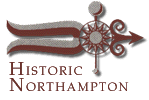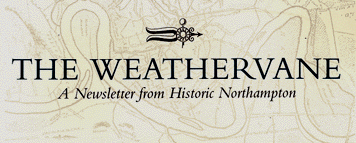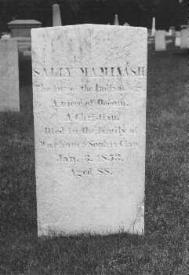

|


Weathervane Newsletter Winter 1996

The True History of Sally Maminash
By Marge Bruchac
Those who tell her story usually begin with the inscription on a gravestone in the Clapp family plot, in Northampton's Bridge Street Cemetery, that reads: "Sally Maminash. The last of the Indians here. A niece of Occum. A Christian. Died in the family of Warham & Sophia Clap. Jan. 3, 1853. Aged 88." The simple marble sits squarely between similarly shaped stones for Sophia and Warham, in front of three small stones for the Clapp children, and is distinguished only by its inscription.
A collection of fading newspaper clippings from the Daily Hampshire Gazette add a few more tragically cryptic details - the theft of her father Joseph's stone from a "lonely grave on Pancake Plain," her mother Elizabeth "stoned to death by local boys," her dying brother "neglected and alone," her grandmother "old. lousy and lame," and Sally, a "wild, passionate, willful" girl who worked as an itinerant spinner and weaver, transformed into a "sweet, saintly Christian," sitting peacefully in her chair reading her Bible. Beyond a periodic recounting of the stereotypical details, no research had been done to place Sally in any historical or social context - she was consistently viewed as a lone Indian, an icon of a "vanishing race."
Sally's story resurfaced, every ten years or so, as "our last Indian," juxtaposed with reports of issues regarding Indians - historical reminiscences, western missionary efforts, archaeological finds, census reports. But "the last of the Indians" is a classic example of a story told "out of context." Almost every town in New England has one, sometimes an entire family - Molly Ockett was called "the last of the Pequawkets" in 1816, Eunice Mauwee was "the last of the Pequots" in 1859, and Paine Henries, "last of the Nipmucks," who died in 1936, was survived by two brothers, a sister, and several nieces and nephews.
The "problem" identifying Indians in the 19th century was compounded by the fact that many had English surnames and occupations. The family of Sampsons described by local historian Sylvester Judd were traditional basketmakers, broom peddlers and hunters. But other local Indians, like the Bakemans, Giggers, Browns, and Burrs recorded by John Milton Earle in his Report...Indians in the Commonwealth, were barbers, laborers and porters...described in different sources as "Indian," "Negro," or "white." Intermarriage was normal among Native Americans, but official records struggled to identify Indians by blood quantum, labeling them as "full-blood," "mulatto," "colored," or "non-white," distinctions based more on the judgment of the recorder than the identity of the individual. Names were similarly mis-reported - Maminash had at least six variants in official records.
Sally was an accepted and skilled member of the local community, working as an itinerant spinner and weaver, when she joined First Church with 76 other people, including the Bakemans, in 1816. She was not even identified as "Indian" in First Church records until Solomon Clark compiled his Historical Catalogue in 1891. Sophia Clapp, who sponsored her, offered Sally a home in her old age, describing her as a friend, not a servant, but later writers seem to have embellished earlier accounts to make Sally appear to be more simple, more destitute, and more alone than she was in real life.
Sally's mother, Elizabeth, came from the community of Mohegan in southeastern Connecticut. Her father, Joseph Maminash, is identified in colonial records as Podunk, Nonotuck, and/or Pocumtuck Indian, and recorded as a resident of Norwich, CT, East Windsor, CT, Southampton, MA and Northampton, MA. Sally's uncle was Samson Occum, Mohegan preacher, fundraiser for Moor's Charity School (later Dartmouth College), and founder of the Brotherton Community of Christian Indians in New York (now in Wisconsin). Occum's mother, Sarah Samson, was distantly related to the Sampson Indians in Hadley. Sally's aunt, Lucy Occum Tantaquidgeon, a powerful church exhorter, was one of the founders of the Mohegan Church in Uncasville, Connecticut. Sally chose to stay in Northampton, her father's homeland.
Sally Maminash's story may end with a stone, but it begins with an example of determinations, of faith, of survival, and of attachment to homeland. Sally was not the only Indian in 19th century Northampton, and she was definitely not the last, but her story can help open the door to reinterpreting Native American histories.
Marge Bruchac is a Native American scholar, Abenaki Historical Interpreter
Contents Historic Northampton.